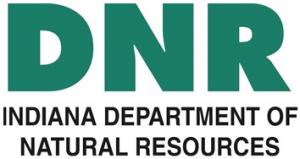
While manicured turf grass is common in backyards, it provides little to no habitat for our local wildlife. Although turf grass has its place for many recreational activities, its short roots create a surface that allows pollutants to run off into our water bodies. Luscious lawns require a lot of maintenance (i.e., watering, fertilizing, mowing), which can be a headache, cost a lot of money, and further contribute to pollution.
Ruby-throated Hummingbird on native cardinal flower. Photo courtesy of the U.S. Fish and Wildlife Service.
Choosing to grow native grasses, trees, wildflowers, and shrubs can provide year-round habitat for Indiana’s pollinators and other wildlife. Native vegetation provides seeds, nectar, and pollen as food for most of our wildlife. Native plants also supply nesting material for many bird species and offer cover for other wildlife.
Landscaping with native plants is generally less maintenance-intensive because they are more resistant to native pests, diseases, and Indiana weather. Their deep roots also slow and filter water runoff, helping to reduce pollutants, such as chemicals and sediment, in our water bodies. Replacing turf grass with native vegetation is a great way to promote clean air, clean water, and healthy soils for both people and wildlife.
Learn more about various wildlife habitat practices or contact your district wildlife biologist for advice.
